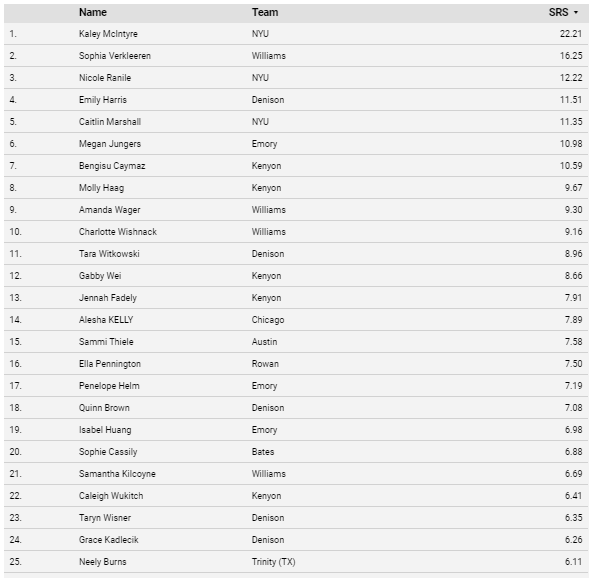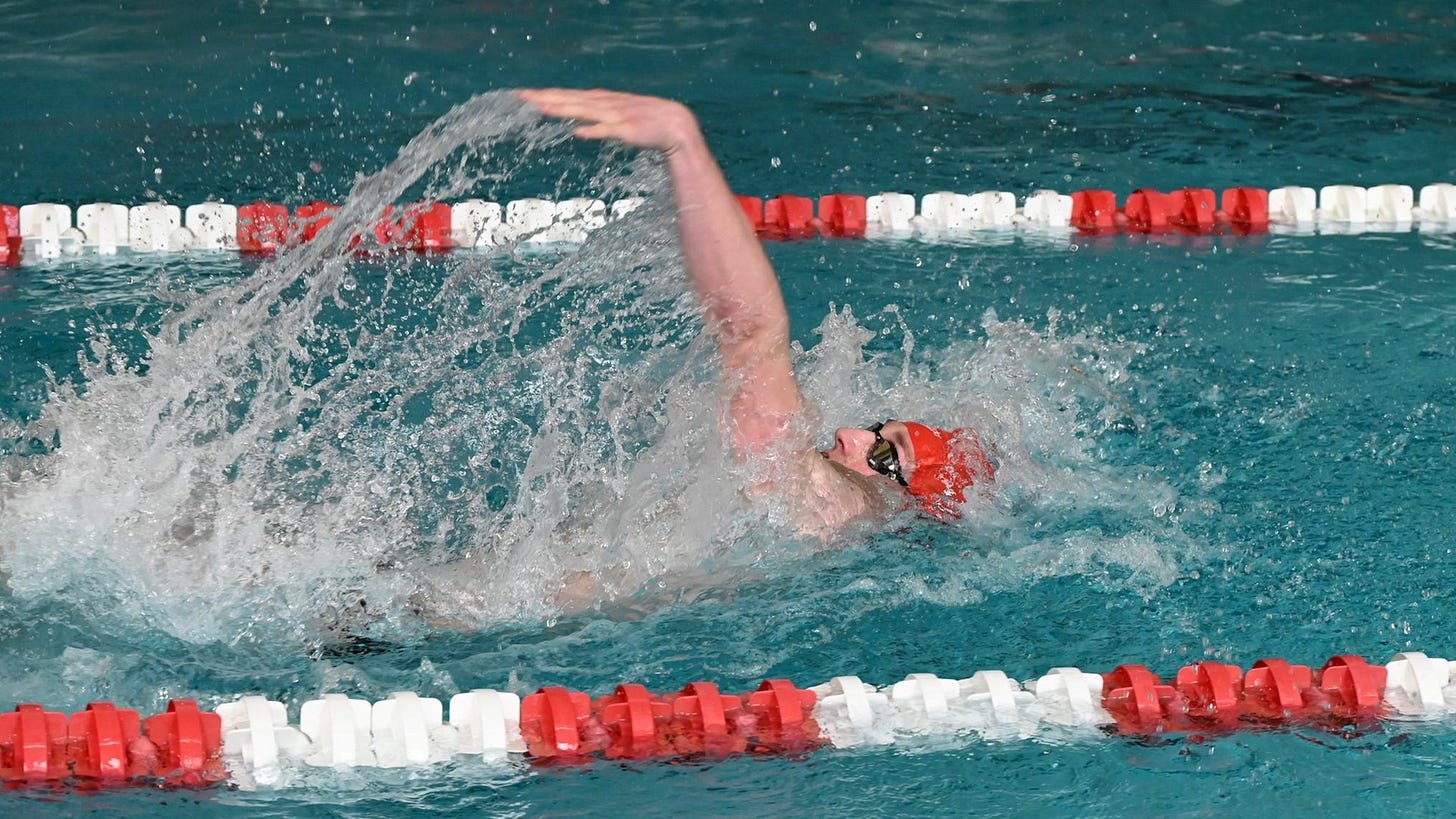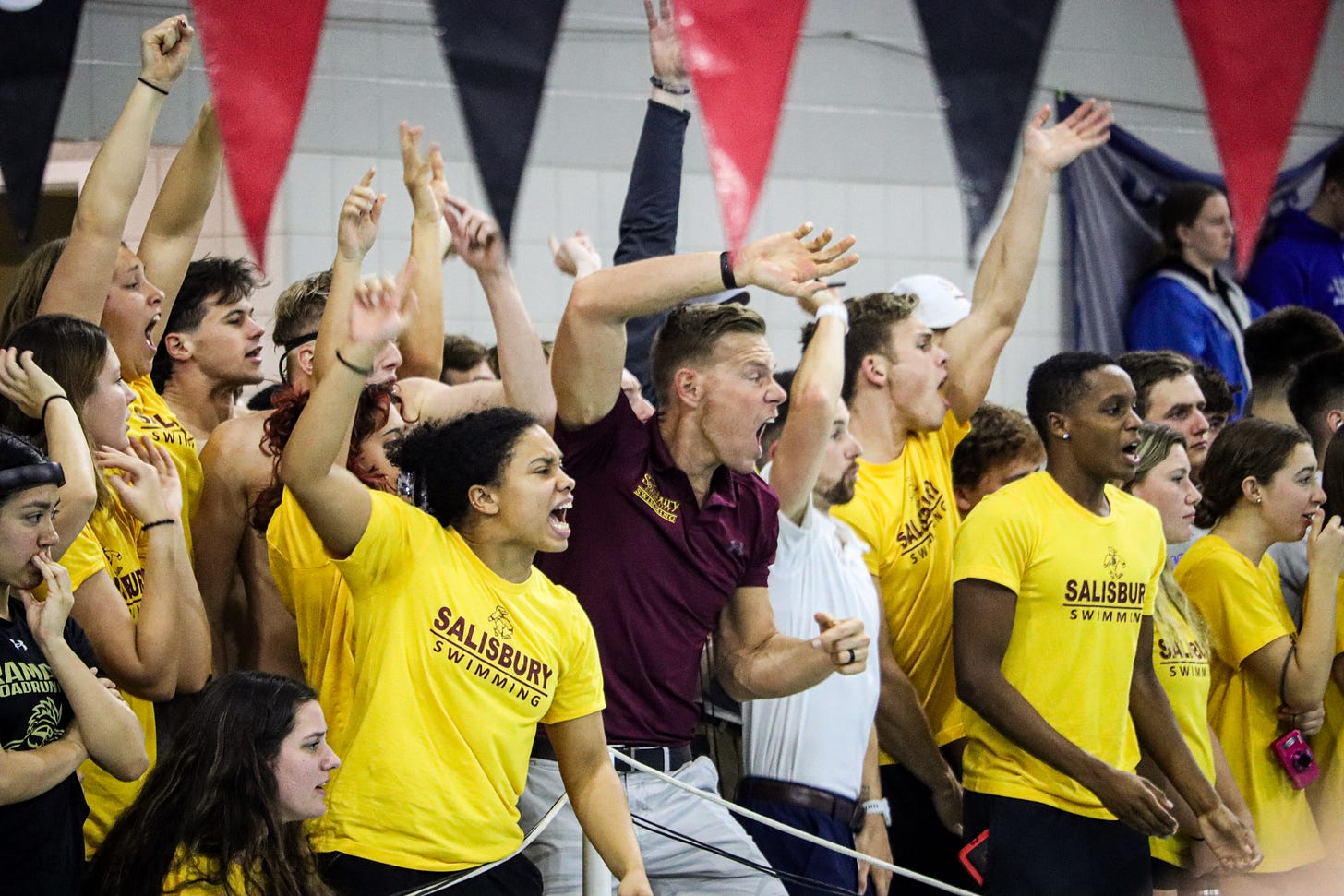Still unpacking
Regular season MVPs and ROYs; preliminary conference champs individual rankings; and Salisbury makes an example of the CSCAA
Let’s hand out some awards.1
Regular season MVP and Rookie of the Year
Women
Women’s regular season MVP: Turns out this is harder than we thought. Here are your top five in total value.
Bengisu Caymaz has the edge on Ella Roberson, but it is so slight that it is hard to know that it means anything. Additionally, they are both First-Years. We guess that Ms. Caymaz’s extra 0.11 gets her the MVP while Ms. Roberson gets Rookie of the Year, but given how close this is, flipping that around would not be a miscarriage of justice.
Men
The Men’s side is also awfully close.
It has to be Derek Maas, and who could object given his performance, but Jake Meyer is really close.
We had to range down to 11th place to include a First-Year, but we think those that have seen Cooper Costello swim during the regular season would agree that he deserves the nod for Rookie of the Year.
Conference Championship Awards
Our inclination is to hand out the same awards for performance in the conference championships. The hitch is that, right now, the NEWMAC, the NESCAC Men and a few other significant conference championships won’t take place until this weekend.
That said the purely quantitative nature of SRS means we can tell you who is in the lead for each award.
Women
Here is your current top 25 based solely on performance at conference championships. No shock. Kaley McIntyre way out in front.
You might recall that Kate Augustyn finished third in the regular season SRS, and we are not counting her out for this round. The NEWMAC conference champs are only a few days away.
Bengisu Caymaz looks good for Rookie of the…Conference Champs, or what ever we call it. But her primary competition is Ella Roberson, who has the NEWMAC championship coming up this weekend.
Men
It is possible that someone in the NEWMAC or NESCAC goes off, but it seems unlikely anyone will catch Derek Maas.
And for Rookie of the CC, as good as Cooper Costello has been all year, Brayden Morford of CMU gets the nod here.
They both lit it up at conferences, but Mr. Morford was unreal. We’ll see if any First-Years in the remaining conferences can challenge what has already been done by those two.
The CSCAA vs. Salisbury
We didn’t start this blog because we like to complain. We started this blog because of a deep fascination with Division III swimming. But sometimes there are irritating things that get in the way of our enjoyment of the sport. Enter the CSCAA Men’s Top 25 ranking.
Here are the Men’s regional rankings for the Northeast-South. Regional rankings precede, and constrain, national rankings. So they matter.
Anticipation: Raise questions about this poll and the immediate response from defenders of the CSCAA is: this is a dual meet poll. Times established in invitationals and championship format meets are considered, but in this poll Team X is ranked ahead of Team Y because Team X beat Team Y in a dual meet, or would beat Team Y in a dual meet based on SwimCloud dual meet rankings or a dual meet simulation.
So, consider this:
Salisbury and Rowan had a dual meet. Salisbury won.
In SwimCloud’s dual meet rankings, Salisbury is ranked ahead of the teams ranked behind Rowan - Ithaca, Gettysburg, Franklin & Marshall, and Drew.
In a dual meet simulation using fastest times, Salisbury beats Ithaca, Gettysburg, Franklin & Marshall, and Drew (although the dual meet against Drew would be fun, and close). These are all terrific teams, and they all deserve to be ranked. Right behind Salisbury.
At NJACs, Salisbury finished 7 points behind Rowan, in a meet where 7,260 points were contested, suggesting that if Rowan is better than Salisbury, they are so by about 0.1%.
While current simulations suggest Rowan would - at this moment - prevail in a dual meet against Salisbury - meaning they wouldn’t lose again to Salisbury, twice in one season - such a dual meet would just even the seasons series, not establish Rowan’s pre-eminence.
Yet, since November, Salisbury cannot sniff the regional rankings despite establishing repeatedly that they are Rowan’s equal, and are better - in the dual meet format - than the teams ranked behind Rowan.
Don’t get us wrong. We love Rowan. They are, along with TCNJ, incredibly important contributors to the Division III swimming landscape in New Jersey. Rowan deserves accolades for what they have accomplished.
But so does Salisbury. And until CSCAA ballots are made public we will never know who has decided that Salisbury’s accomplishments don’t deserve the same recognition given to the teams they beat.
Earlier today we circulated the new SRS sort/filter table where you can compare any swim to any other swim, and limit your search to just performance at the recent conference meet.
Then of course we started playing with an underlying data and then next thing you know we had a table, this one aggregating all positive SRS scores into one SRS score per swimmer.
Most teams don’t send anyone to Nationals. The regular season in Division III ends when the conference championship starts. For the overwhelming majority of teams and athletes, conference championships are the entirety of the post-season. Not every conference championship has started, but for all teams the regular season is done.
We like our method more than the SwimCloud approach because a) their point system is arbitrary and wildly uneven, and b) SwimCloud requires that each swimmer generate those points in four events - no more, no less.
A. It is arbitrary because: SwimCloud takes as a baseline the Division I record in the event, which makes less sense the more you think about it. One obvious example: why should Division III Women’s distance swimmers generate fewer points for an above average performance just because Katie Ledecky chose to go to college, while Division III Men’s IM swimmers get a boost for an above average performance simply because Michael Phelps chose not to go to college? If it is not clear to you how that problem appears in the SwimCloud points system, say something in the comments and we will elaborate.
B. For many swimmers it makes no sense to require that they are scored on four events. SwimCloud knows that and so finds a lot of artificial ways to shoe-horn the athlete into that requirement.
We say, simply, if you have positive SRS points in an event, it counts towards your score, whether that is the case in one event or six events. It has to be a good enough swim to garner positive SRS points - which means it has to be a very fast swim - but we don’t determine in advance how many events should be factored into the athletes overall value.
Since all swims in all events are on the same scale (tied to the D3 average time in that event among the top 100 swims per year for the last four full seasons), real comparison is possible. And a point in one event is comparable to a point in another, so adding the points together makes sense.












Strong work guys! Great blog! So much fun to read! Regarding the Rookie of the CC, how does Calista Lynch of NYU compare? She absolutely crushed it at UAAs.
This is interesting to learn. SU is an incredible team. How do we get some attention?